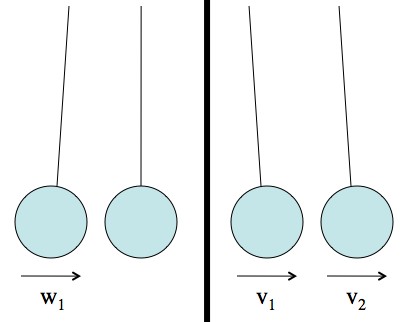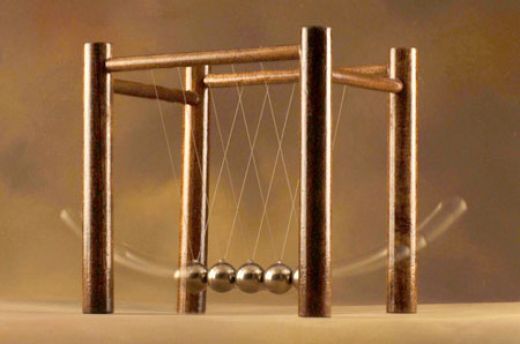The original question was: With the game for executives, consisting of several metal balls hanging in a straight, horizontal row (a “Newton’s cradle”), when one ball is lifted and let loose to hit the rest of the row, only one ball at the other end gets swung away in its arc. And so the is case with two balls with two balls, and with three balls the response is with three balls, etc.
The question: Why the reaction to one ball is always one ball and not two balls to a shorter distance, or the reaction to three balls, one, or two balls to a greater distance, etc?
Physicist: For those readers who haven’t seen one of these since the 80’s, here’s what we’re talking about.
In every collision you have conservation of momentum. But, when things collide they can heat up, produce sound, or otherwise lose a little kinetic energy. For example, when you throw two blobs of clay straight at each other: they start out moving, but after the collision they stick together and barely move. The collisions that lose energy like that are called “inelastic collisions”.
When a collision conserves energy it’s called an “elastic collision”. As you might imagine, steel balls don’t change shape much when they collide: the collisions are elastic and do conserve kinetic energy almost perfectly.
For a momentum-and-energy-conserving-collision between two balls, one of which is stationary, you can show that the only way for everything to balance out is for the balls to “switch”.
To extend this to the full multi-ball executive ball clicker, you can think of the whole thing as just a string of two-ball collisions. Ball one hits ball two hits ball three … and each time all of the movement is transferred from one ball to the next. The exact same idea is responsible even when you swing several balls at the same time: it’s just a string of very rapid two-ball collisions.
If you were to build one of those executive ball clickers with rubber or wooden balls (which would absorb a little kinetic energy) you’d find that you’d get all of the balls moving, instead of just the one on the far end. The one-ball-in/one-ball-out thing only works with very solid balls.
Answer gravy: The nice thing about a Newton’s Cradle is that the impacts happen in only one direction, which makes the math much easier.

The before (left) and after (right) velocities. Showing that executive ball clickers work boils down to showing that v1 = 0.
If the mass of every ball is , the velocity of the original moving ball before the collision is
and the velocities of the two balls after the collision are
, then:
Conservation of momentum can be written:
Conservation of energy can be written:
You can clean these up a bit to get and
Using that result, and remembering that w1 = v1+v2, the only two possible solutions are “v1=w1, v2=0″ or “v1=0, v2=w1“. The first solution would imply that the first ball ignores the second and moves through it. The second solution is what you see: the impact switches which ball is moving and which is stationary.
In the case of an inelastic collision you have a larger initial kinetic energy and a smaller final kinetic energy. Energy conservation can then be written: or
, where
is the energy lost to heat or sound. Running through the same math as above you’ll find that
. Suddenly that last “one of them has to be zero” step doesn’t work, and you find that the kinetic energy has to be divided up between the balls.
This question was surprisingly tricky. The fact that the balls are arranged in a line turns out to be very important. If the impacts aren’t in a straight line, or if the first ball hits more than one other ball at a time, then the “executive ball clicker effect” goes away.








18 Responses to Q: How do those “executive ball clicker” things work?